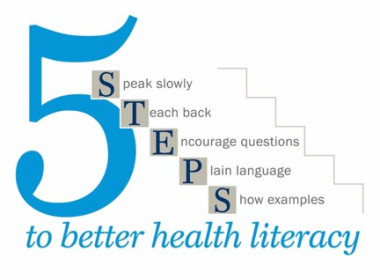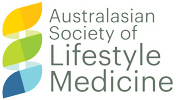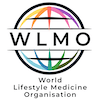Health literacy in professional practice for type 2 diabetes
Health literacy is a vital component of self-management. Clients who are unable to understand, interpret and act upon health care information will have minimal success in maintaining control of their disease or condition. This is particularly true for Type 2 Diabetes as there are complex actions required on a daily basis to successfully manage this disease process.
Approaches that may be useful to incorporate in a health care setting to support health literacy are outlined below.
Initial contact
A well designed, client centered waiting area with printed, easy to read health-promoting information, and a television with looped health promoting messages targeting positive health care and interventions for type 2 diabetes. These initiatives give clients the opportunity to read, listen, or view health messages at a relaxed pace. Information available and transmitted in multiple forms and languages (relevant to the population base) will support client learning. This information needs to be assessed at a year five to seven reading level1. This information can be available for clients to take home to view or read in their own time.
Long appointments and/or group appointments
Clients with low health literacy will benefit from more time spent with the clinician to have questions answered and ensure that messages delivered have been interpreted correctly. Group appointments allow additional time for clients to consider questions, as well as benefit from questions asked by other clients in the appointment. Although current research regarding group/Shared Medical Appointments does not specifically address health literacy, evidence is mounting that clients who participate in group visits are better equipped to manage their disease process 2. This may be due to the increased sharing of information and experiences from other clients and the clinicians present.
Clinician characteristics
There are a number of clinician-specific attributes to consider that will facilitate health literacy.
Clinicians’ need to:
- Slow down, take the time to assess the client health literacy – long appointments as above will help. This includes speaking slowly and encouraging questions, looking for the signs of low literacy including; not reading, giving excuses, not understanding prescriptions, not following through with appointments and keeping large quantities of paper notes with them.
- Use everyday language rather than medical terminology and jargon.
- Use visual aids such as drawings and pictures.
- Give small bites of information during interactions and repeat instructions.
- Confirm understanding by having the client ‘teach back’ or demonstrate what has been taught.
- Show respect, sensitivity and caring to encourage clients to participate in their health care3.
Using the ‘5 Steps to Better Health Literacy’ as developed by the St Vincent Charity Medical Centre is an easy way to remember and incorporate health literacy reminders.

Peer delivered education
Programs delivered by chronic disease clients rather than health professionals, such as the Stanford Program, have been shown to be very effective in enhancing health literacy1. The Stanford Program is evidence based and shown to have good success for chronic disease self-management5. Referring clients to, or having a program such as this in the practice will encourage participation.
Take home information
Self-management occurs outside the clinical practice setting. Clients need take-home information they can review regularly to support learning and implementation of interventions and goals set with the clinician. Take-home information for diabetics should be in multiple forms such as:
- Individual information sheets on the basics of self-management, for example; nutrition, foot care, physical activity, insulin and self-medication;
- Diabetes self-care record and identity card;
- Audiovisual aids demonstrating foot care and self-injection of insulin that include testimonials from other diabetics regarding their self- management experience. This can include CD’s or pod casts available on a clinic web site.
All such information needs to be checked for readability at primary school level. Clients with high general literacy also benefit from health information in easy to understand language3.
Most persons with low literacy feel ashamed and make excuses to cover and hide this deficiency. Using language that normalises the difficulty of understanding complex medical information can put a client at ease and break down barriers to admitting health illiteracy. All clinicians need to be sensitive to this issue to support clients to achieve self-management – being client centred and empathetic will support this goal. Using numerous forms of communication enables clients to access information in a manner that is understandable for them. No one form of communication will be relevant for every client, and clinicians can learn to watch for cues to the best form of learning for the client and address medical information in that format.
- Levin-Zamir D, Peterburg Y. Health literacy in health systems: perspectives on patient self-management in Israel. Health Promotion International. 2001 March 1, 2001;16(1):87-94.
- Ridge TDNPANPBCBCADM. Shared Medical Appointments in Diabetes Care: A Literature Review. Diabetes Spectrum. Spring 2012;25(2):72-5. PubMed PMID: 1021243874. English.
- Safeer RS, Keenan J. Health literacy: the gap between physicians and patients. American Family Physician. 2005;72(3):463-8. PubMed PMID: 16100861.
- Center SVCM. 5 Steps to better health literacy 2013 [1/1/15]. Available from: http://www.stvincentcharity.com/services/centers-and-institutes/health-literacy-institute/what-were-doing/.
- Medicine SSo. Chronic Disease Self-Management Program (Better Choices, Better Health Workshop) [16/5/14]. Available from: http://patienteducation.stanford.edu/programs/cdsmp.html.
This article has been written for the Australasian Society of Lifestyle Medicine (ASLM) by the documented original author. The views and opinions expressed in this article are solely those of the original author and do not necessarily represent the views and opinions of the ASLM or its Board.



